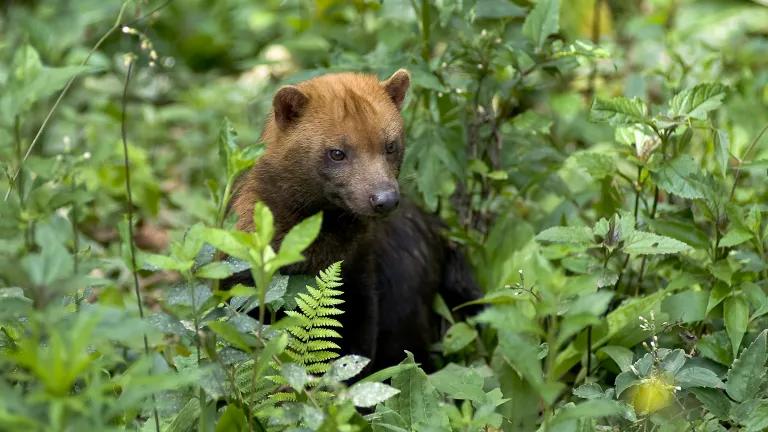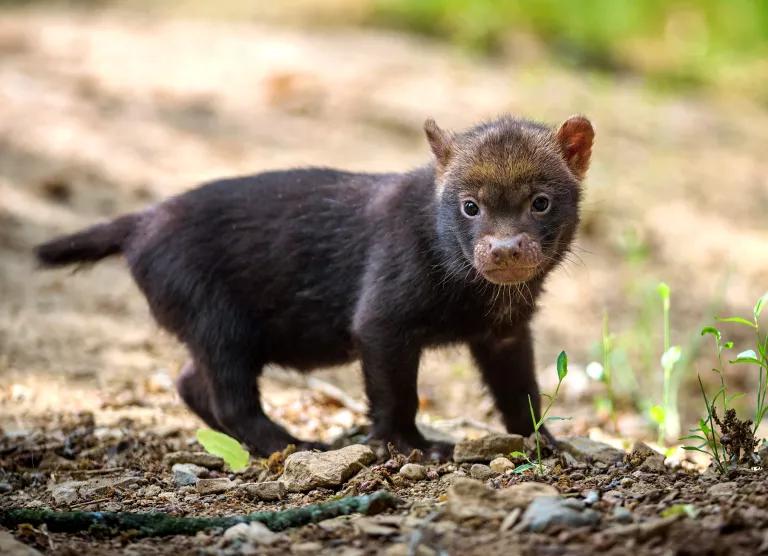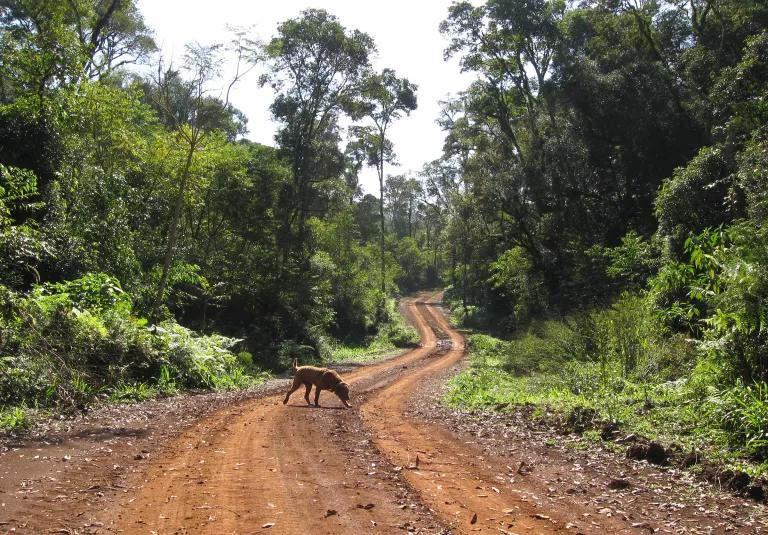A Rescue Dog Is Now Helping to Save Other (Much Wilder) Dogs
Where are South America’s bush dogs? A scientist looks to a Chesapeake Bay retriever for answers.

An adult bush dog, part of a captive breeding program
Formidable predators stalk the forests between Panama and northern Argentina. They are sometimes heard but never seen. They are small but feisty and have even been documented trying to take down a tapir, which can top out at nearly 400 pounds. Chupacabras? No.
Bush dogs.
This wild canid is about the size of a Scottish terrier but looks more like a rust-colored wolverine than any Toto you know. Not that you’ll ever see a wild bush dog in person. Even those who have lived their whole lives in these forests are often unable to identify the species from a photograph.
“But they know bush dogs by their songs,” says Karen DeMatteo, a biologist at Washington University in St. Louis. That’s right—they sing.
Like most canids, bush dogs are highly social. They spend nearly all of their time in tight-knit family groups, and they hunt as a team, joining forces to catch and kill everything from small rodents like pacas and agoutis to larger prey such as armadillos, deer, and capybaras. They use a variety of vocalizations to coordinate their attacks, and to the untrained ear, DeMatteo says, these songs sound like a lot like bird chirps in the night.
From Brazil and Paraguay to Argentina, DeMatteo has spent more than a decade chasing these reddish-brown ghosts. She’s interviewed locals, set up countless camera traps, and even scoured the ground for bush dog droppings. And by her side, helping her sniff scat and track his wild and distant cousins, is a seasoned Chesapeake Bay retriever named Train.
DeMatteo’s work, which includes around 15 published studies, makes up a hefty portion of the science used by the International Union for Conservation of Nature (IUCN) in 2011 to classify bush dogs as near threatened. And yet, we still know next to nothing about these animals.
“Bush dogs are just one of those species that are almost impossible to study,” says DeMatteo.
For starters, these skittish canines are nocturnal, active mostly under the cloak of darkness. But you won’t find them napping under the sun either. “From morning to evening, they’re underground,” says DeMatteo. “So unless you know they’re underneath you, you could walk right over them and have no idea that you’re walking over a bush dog.”
From a handful of bush dogs she was able to capture and collar, DeMatteo learned that the predators will hole up in burrows dug by armadillos (presumably after they eat them). The canids can dig their own tunnels too, thanks to their partially webbed toes. Bush dogs also dig as a team, with one animal breaking ground at the front of a tunnel and another clearing material from the hole’s entrance. DeMatteo says once she even saw a pup adorably pawing at the dirt while its parents labored—kind of like when I used to follow my dad around the yard with my bubble-blowing lawnmower.

Bush dogs also seem to have an uncanny ability to avoid humans. Even camera traps have a tough time picking them up, though this could be because we’re putting them in all the wrong places. “Most people put camera traps along roads to capture the animals like pumas and jaguars walking up and down trails,” DeMatteo says. “But bush dogs don’t walk along trails. They cut across trails.”
Their elusive behavior may be one reason why these animals have managed to persist in numerous habitats, from rainforests to plains to wetlands, across a wide swath of Central and South America. Unfortunately, the animals have not evaded humanity’s influence completely, as evidenced by their seemingly sparse populations. According to the IUCN, potential bush dog territory spans more than four million square miles across the South American continent, but surveys suggest fewer than 110,000 individuals live in all that territory—and only half of them are mature and reproducing at any given time. Even those paltry numbers are probably an overestimate.
The bush dogs’ seemingly flexible behavior, says DeMatteo, could be a blessing and a curse. For instance, they seem to be able to survive in areas of human disturbance, but as timber, mining, and agricultural operations continue to fragment wild habitats, the dogs must traverse larger and larger territories in search of food.
Eking out a living near humans also brings bush dogs into closer contact with domestic dogs, which can introduce potentially lethal diseases, such as canine distemper, leishmaniasis, and mange. “And when it kills them, it usually kills the entire group, because they’re so social,” says DeMatteo. In fact, an outbreak of mange wiped out one of the packs she and her colleagues were studying in Brazil. A hunting dog had likely introduced this parasitic disease when it entered the bush dogs’ burrow looking for pacas.
But Train is not like other dogs. He’s helping to carve out some territory for bush dogs through a wildlife corridor project DeMatteo is working on with a grant from the National Geographic Society. Since there isn’t a lot of conservation work focusing on bush dogs exclusively, DeMatteo hopes that bigger projects like this will include the canines under their protective umbrella. When completed, this 50-mile, 100,000-acre corridor in northern Argentina could benefit all of the region’s wildlife, including charismatic icons like jaguars, ocelots, tapirs, and peccaries as well as more under-the-radar species like the tiny, spotted jungle cats known as oncillas and, of course, bush dogs.
Plotting out the lands suitable for the corridor, however, requires first proving that the target animals still exist there. That’s where Train comes in.

The 11-year-old retriever can identify nine different species, including bush dogs, entirely on the scent profile of their excrement and spends his days dashing off into the underbrush to draw attention to overlooked piles of scat. DeMatteo then analyzes the DNA within these samples to double-check what species they belong to. In other words, Train’s sniffer provides a glimpse into the bush dogs’ world that we simply can’t get using other methods. (Not bad for a Humane Society rescue, right?)
Train also benefits the project by charming his way onto properties where researchers aren’t always welcome. DeMatteo explains that many landowners are wary of scientists who come looking for poop, thinking perhaps that they’re from the government and want to eventually take their land. The idea of a dog hunting for pacas or bush dog droppings is a lot more agreeable.
“We tell them what Train does and they’re like, “Oh, sure, can I come with you?’” she says.
“I think that’s one of the most bizarre ironies,” says DeMatteo. “Domestic dogs are such a major threat to bush dogs, and here’s this domestic dog being kind of like a savior, opening new doors for us and collecting data that nobody else has ever collected.”
Good boy, Train.
This article was originally published on onEarth, which is no longer in publication. onEarth was founded in 1979 as the Amicus Journal, an independent magazine of thought and opinion on the environment. All opinions expressed are those of the authors and do not necessarily reflect the policies or positions of NRDC. This article is available for online republication by news media outlets or nonprofits under these conditions: The writer(s) must be credited with a byline; you must note prominently that the article was originally published by NRDC.org and link to the original; the article cannot be edited (beyond simple things such grammar); you can’t resell the article in any form or grant republishing rights to other outlets; you can’t republish our material wholesale or automatically—you need to select articles individually; you can’t republish the photos or graphics on our site without specific permission; you should drop us a note to let us know when you’ve used one of our articles.

These 5 Animals Would Be Goners Without the Endangered Species Act
Finally, a High Seas Treaty to Protect the World’s Oceans
Can Anything Be Done to Stop Overfishing?